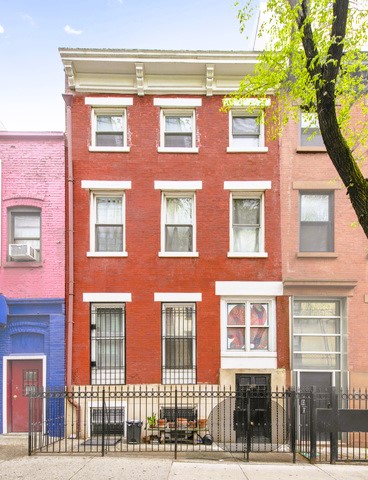In 1851 the family of William S. Moore lived in the brick-faced house at 184 West 25th Street (renumbered 278 in 1865). The modest, middle-class home was three stories tall above an English basement. Its builder borrowed elements from the established Greek Revival and emerging Italianate styles--the former in the plain, flat lintels and low third floor, the Italianate in the floor-to-ceiling parlor windows and the foliate-bracketed cornice.
Moore, who was an importer with offices on Maiden Lane, remained in the house until 1861, when he sold it to Enoch Stratton, a builder. Moving in with Stratton and his wife were their daughter Mary Anna, her husband Edward Scantlebury, and their toddler grandson Joseph.
The family had barely settled in when tragedy occurred. Joseph Scantlebury died two months before his third birthday on March 12, 1861. His tiny casket sat in the parlor until his funeral there two days later.
It appears that Stratton's wife tried her hand at running a boarding house in 1864. That year five other persons are listed at the address--merchant John Anderson; George Billings, who was a printer; Cornelius Meyers; and two educators, Henry K. White and Evelina Kellogg.
Apparently the venture did not work out. In 1865, only George Billings and Evelina Kellogg were boarding with the family, and George's stay was cut short when he was drafted into the Union Army on March 18.
Stratton and his family lived on at 278 West 25th Street through 1874. The following year the house became the "office and residence" of the colorful Madame Clifton. Her exhaustive advertisement in the New York Herald in October that year touted:
A business and medical clairvoyant, who has no equal in America. $10,000 reward is offered to any one who can equal Mme. Clifton, the greatest Clairvoyant in America. [She] can give us correct information on losses, law-suits, absent friends and business matters of all kinds. She can allay the most serious trouble; located and prescribed for all diseases. She manufactures a wash called Chinese Hyso, warranted to remove freckles, moth patches, and all eruptions of the skin, and render it perfectly smooth. This is no humbug; nor does she wish to impose on the unwary. She can refer to the most prominent citizens of New York, Boston, Philadelphia, and other cities. All who are sick or in trouble will please call and verify the above statement. Office and residence, 278 West Twenty-fifth street, third door east of Eighth avenue.
Another ad for Madame Clifton in February 1876 that year said she "locates all diseases, makes wonderful cures; on losses, law suits, absent friends or business matters she never fails. All who are sick or in trouble should visit this wonderfully gifted lady." The ad cautioned, "no likenesses or love powders."
But then, as was often the case with clairvoyants and spiritualists, she quickly moved on. George H. Barr, a clerk, was listed at the address later that year.
From 1879 until around 1893, detective John H. Conway owned 278 West 25th Street. Born in 1843, he served on the Monitor during the Civil War when it engaged the Merrimac in battle on March 9, 1862. An ardent Democrat, he became active in politics in the 1870s and was treasurer of Tammany Hall in the 1880s. In 1893 he was made Deputy Tax Commissioner in Long Island City.
At the turn of the century, William Kroplins and his wife ran 278 West 25th Street as a boarding house. On the night of August 27, 1904, they rented a room to a young dressmaker, Lucy Alexander, who had a 14-month-old child with her. She explained that she had just arrived in New York from Philadelphia where had visited friends.
The following afternoon, at about 3:00, Mrs. Kroplins noticed the woman's door was open and "peeped in," as worded by The Sun. "The room seemed deserted, so she walked inside and, on the bed, found the dead body of the child." She called her husband who, after deciding that mother had fled, notified the police.
An hour later Lucy returned to the house with several other women. She explained that earlier that morning, "her child was seized with convulsions...and died. She hurried out to find friends to help her arrange for the burial, not supposing that any one would enter her room in her absence." It appears that the authorities accepted her explanation, and she was not charged with any crime.
The house was unofficially converted to apartments during the Depression years. The stoop was removed and the entrance lowered to the basement level.
A subsequent renovation completed in 1971 resulted in furnished rooms and one apartment. The building continued to be operated as a rooming house until 1991 when it was remodeled into an apartment in the basement and a triplex above.
In 2020 the stoop and entrance were reconstructed, so that today the house looks much more like it did when William S. Moore moved his family in more than 170 years ago.




.png)
No comments:
Post a Comment